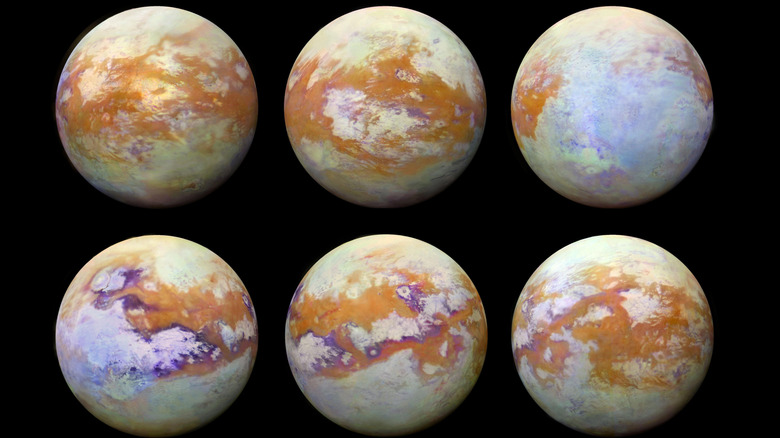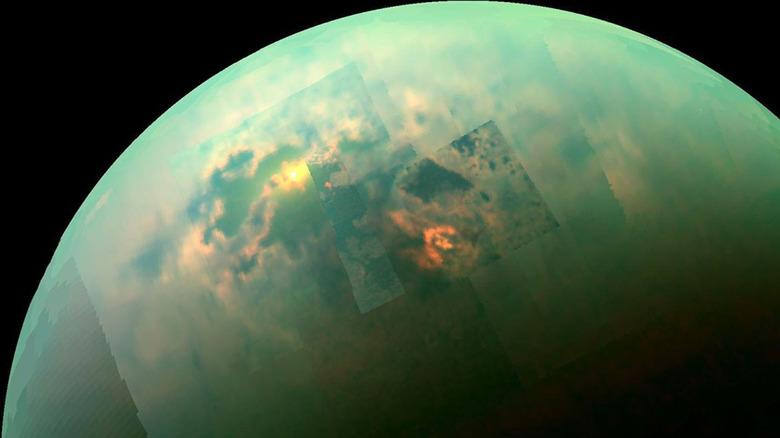The Weather On Saturn's Biggest Moon Is Gnarly - Here's How NASA Tracks What It's Doing
Cloudy with a chance of rain? That's not only the forecast on Earth but in some other locations in our Solar System too. Recently, researchers, using data from the James Webb Space Telescope, have been investigating the weather on Saturn's moon Titan, and they've found some bizarre weather phenomena that are quite different to what we see on our planet.
"Titan is the only other place in our Solar System that has weather like Earth, in the sense that it has clouds and rainfall onto a surface," explained the lead author of the study published in Nature Astronomy, Conor Nixon of NASA's Goddard Space Flight Center. Titan is Saturn's largest moon, and it's of particular interest to researchers and space agencies like NASA because there's a possibility that it could host life. One of the things that makes Titan unusual is that it is the only moon in our Solar System which has a meaningful atmosphere, so in some respects its environment is more like that of a planet than a moon.
Another oddity about Titan is that it has liquids on its surface. But unlike Earth, the liquids aren't water, as it's far too cold there — around -290 degrees Fahrenheit or -179 degrees Celsius on the surface. Instead of water, Titan has rivers, lakes, and even seas that are made of ethane and methane, which we typically see as gases here on Earth. This methane and ethane carves out shapes in the frozen water ice which makes up Titan's thick shell, just like rivers of water carve through rocks on Earth.
Floating clouds
As there is liquid on Titan's surface, it has developed something like Earth's water cycle, and it experiences clouds and rainfall of methane. To study these in more depth, researchers turned to the powerful James Webb telescope which is able to look at the chemical composition of the moon's atmosphere.
This adds to data taken back in 2004, when NASA's Cassini spacecraft and the European Space Agency's Huygens lander studied the moon. "Webb's observations were taken at the end of Titan's northern summer, which is a season that we were unable to observe with the Cassini-Huygens mission," said another researcher from the new study, Thomas Cornet of the European Space Agency. "Together with ground-based observations, Webb is giving us precious new insights into Titan's atmosphere, that we hope to be able to investigate much closer-up in the future with a possible ESA mission to visit the Saturn system."
Webb observed Titan in November 2022 and July 2023, alongside the ground-based W.M. Keck telescope, and was able to see clouds that were rising to higher altitudes in the northern hemisphere of the moon where it is currently summer. Scientists had previously seen clouds moving in the southern hemisphere, but not in the northern hemisphere where most of the methane lakes and seas are. Using Webb's instruments, the researchers could peer into the 30 mile-deep atmosphere and see clouds gently wafting upwards over several days.
A chemical cake
The methane on Titan forms a cycle of liquid on the surface to evaporation to clouds to precipitation back to the surface, just like the water cycle on Earth. However, on Titan the methane can also react in the atmosphere. For example, the methane molecules in Titan's atmosphere can get split apart due to radiation from the sun or from energetic particles from Saturn's magnetic field, called its magnetosphere.
The methane molecules can then recombine with other elements, forming compounds like ethane and others. The new observations definitely detected one of these molecules, the methyl radical CH3, for the first time. That means that the researchers were able to see the active chemistry happening on Titan. Rather than just seeing methane or ethane, as has been observed before, they were able to see the process of methane breaking apart.
"For the first time we can see the chemical cake while it's rising in the oven, instead of just the starting ingredients of flour and sugar, and then the final, iced cake," said co-author Stefanie Milam of the Goddard Space Flight Center. They could also look at the complex balance that is occurring on Titan. Each time a methane molecule breaks apart, some of its hydrogen is lost when it evaporates into space. That means that over time, methane is being lost, and it's not yet known whether that means that the atmosphere will become less hospitable over time.
"On Titan, methane is a consumable. It's possible that it is being constantly resupplied and fizzing out of the crust and interior over billions of years," said Nixon. "If not, eventually it will all be gone and Titan will become a mostly airless world of dust and dunes."


